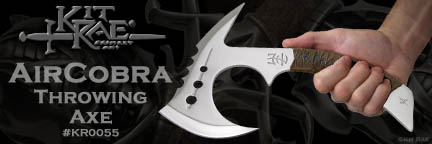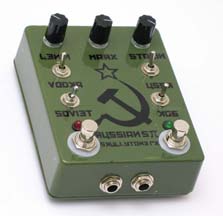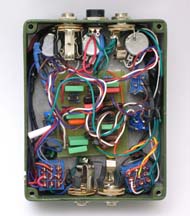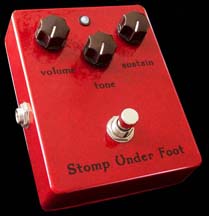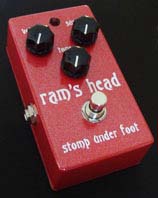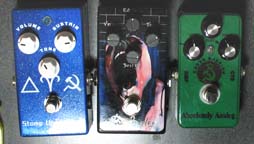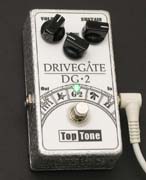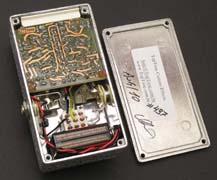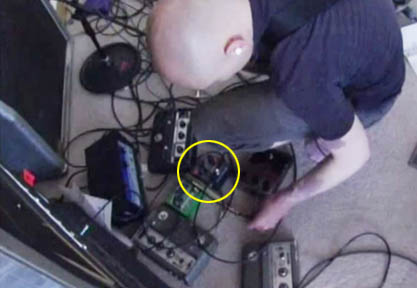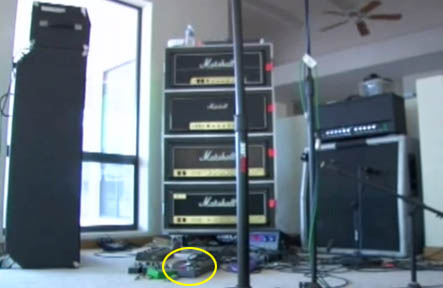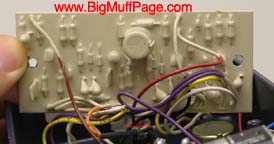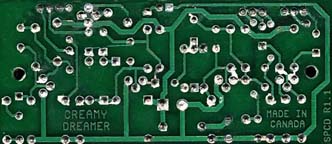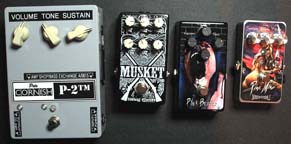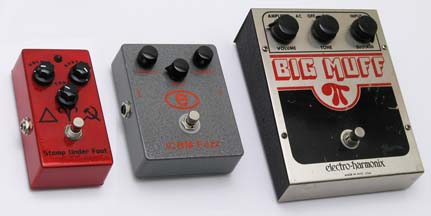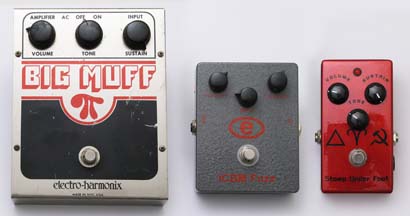Kitís Secret Guitar, Gear, and Music Page
Guitar stuff, gear stuff, soundclips, videos, Gilmour/Pink Floyd stuff, photos and other goodies.
Copyright Kit Rae.
VINTAGE BIG MUFF CLONES AND BOUTIQUE BIG MUFF BASED PEDALS - Page 2
There have been many clones of vintage Big Muffs made throughout the years and many pedals that were inspired by the Big Muff four stage circuit. Some are basically exact copies of particular Big Muff circuit and others feature unique modifications and improvements. Here are reviews of a few of my favorites. You won't find reviews here of any clones that are not well made, or that do not sound good. If I do not like a pedal, I simply don't review it. There are many good clones that I have not reviewed yet, so just becasue it is not here does not mean it is not any good.
BLACKOUT EFFECTORS MUSKET • B.Y.O.C. LARGE BEAVER
PETE CORNISH G-2....•....PETE CORNISH P-1....•....PETE CORNISH P-2
SKREDDY P-19 ...•..... SKREDDY PINK FLESH.....•......SKREDDY PIG MINE
SKULLYTONE FX RUSSIAN SPI ....•.... TOPTONE DG-2
STOMP UNDER FOOT '73 RAM'S HEAD - THE BRICK MUFF
STOMP UNDER FOOT CWM - Cival War Muff ...........STOMP UNDER FOOT VRH - Violet Ram's Head .......STOMP UNDER FOOT - Op-Amp Fuzz
NOTE - I have listed the gear and settings I use in most cases, for reference, but note that the tones may not exactly match your rig, depending on which amp you use, your guitar, pickups, and fingers :)
Skullytone FX Russian Spi - This is a Sovtek based Big Muff with many of the popular Big Muff mods built in and switchable. It is made by Skullytone FX. Mark at Skullytone has been hand making a few of his boutique pedals each week for several years. I remember seeing a photo of the Russian Spi on the web a few years back, and thought, what the heck is that thing? I went to look for it again and could not find it, then a few months ago one turned up and ebay, so I snagged it. Turns out it that is how Mark sells his pedals. He did not not have a website at the time I wrote this review, but he does have a Myspace page. That's about the only way you can contact him (though if you are interested, email me and I will give you Mark's email). His pedals are sold by word of mouth and ebay.
Anyway, the reason I wanted to try this pedal was due to all the switchable mods on this thing, and the fact that it had switchable Germanium and Silicon clipping modes. The goofy graphics and sheer number of toggle switches made me wary that this may just be some junky hack job pedal, but I went for it anyway. Here is a breakdown on the sounds.
STANDARD MODE - Lenin/volume, Marx/treble, Stalin/sustain - Theese are the standard Big Muff controls. It is definitely a Sovtek style big Muff circuit at it's core. I nailed the vintage smooth Civil War Sovtek and crunchy Green Russian Sovtek tones easily with the standard settings. For these tones alone, it is worth the $140 price paid just as an accurate sounding clone of a Sovtek 1990s era Big Muff.
VODKA and USSR toggle switches - These are the clipping mod controls. Up selects Germanium diodes for a warm tone, something you won't find in many of these Big Muff based pedals. In fact, the only other Muff clone I can think of that uses Germanium clippers is the Cornish G-2. Middle position removes the diodes from the circuit, like some of the old Tonebender circuits. Down selects standard Silicon diodes for the stock Sovtek Big Muff sound. You can independantly switch the two clipping sections to mix and match these options, but I found that either both set on Germanium, or both set on Silicon were the two sounds I liked best. One big negative is the huge volume disparity between the Silicon and Germanium settings, something that is unavoidable due to the nature of these two diode types when using a simple switch setup like this. You have to adjust the pedal volume a lot when using one or the other. It's a huge difference. The Germanium setting is VERY loud. It would involve more components and a higher cost to fix this problem, but I have to point it out because if you are playing live and want to change from song to song, you have to do more than just flip the switches.
SOVIET toggle switch - This is an emitter lift mod, similar to the popular Creamy Dreamer mod. Up is standard Big Muff mode, and down is the emitter lift mode, which gives you a nice gain boost. This works especially well when using the Germanium diode selection. There is middle position that does nothing but kill the signal. Not sure why Mark did not use a two way switch here, as this is a bit annoying.
KGB - The is a tone bypass switch plus a volume boost. Similar to the tone bypass on the old V5 and V6 EHX Big Muff, and the bypass on the EHX Tone Wicker Big Muff, It completely bypasses the tone circuit, so no Big Muff mid hump. Just the full on clipped Big Muff gain section. This sounds absolutely killer when you use the Germanium diode settings and the gain boost from the SOVIET switch. It gives you some abolutely screaming old school, blissful overdriven fuzz! One negative with this switch is it is also a three way, so up or down positions do absolutely nothing. It woud have been better with a simple on off toggle or switch.
The noise level is abut average for a Big Muff. More gain equals more noise, but not bad for a Muff. I compared the Germanium setting to see how close it sounds to the Cornish G-2. Much more Fuzz Face type warmth and more bottom end to the sound than the G-2, but similar. Think a Fuzz Face/Big Muff mix. That's exactly what this setting on the Spi sounds like. Switching one set to Germanium, and one set to Silicon gets really close to the G-2 though, but with more bottom end.
Taking a look under the hood, at first glance it looks a bit messy compared to some other really clean boutique circuit guts on other pedals I own, but there is a lot crammed into this pedal too! The solders all appear to be quite solid and Mark has put heat shrink around all the solder joints that count. Components all appear to be high quality. mark uses Mallory, Sprague, and Wima caps, and metal film resistors. Transistors are 2n5088. True bypass switched. 3 3/4" x 4 3/4" enclosure, with jacks on the top end. The finish and graphics quality are about average. It's acceptable, but the pedal could have used another 3-4 coats of clear to hide the edges of the graphic transfers. The graphics themselves - I love the classic Russian Muff green color and the hammer/sickle/star, but honestly, I don't care for the Russian labels under the controls. I would have rather had proper labels for the individual functions. Looking at Mark's other pedal graphics, this seems to be his style though. Some are pretty glaring and out there. The pedal does not have space for a battery, but runs on a standard 9v Boss type adaptor. I'm not using it, but a nice feature Mark also included is an extra switch that controls a built in bypass loop, with in/out jacks on the bottom end. Not all the Russian Spis have this, and some of the Spis I have seen Mark selling on ebay have slightly different mod controls than mine.
Overall, I was very impressed with the sound quality and range of tones I was able to get out of this. Considering it costs around $140, and many other boutique Big Muff pedals with less features are much higher, this is a bargain.
Review written July 2010
Stomp Under Foot '73 Ram's Head - the Brick Muff
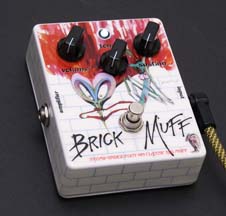
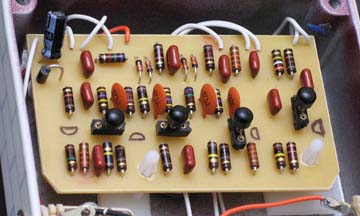
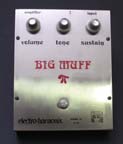
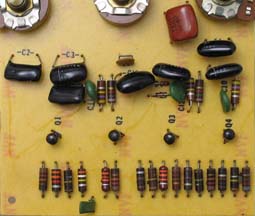
Stomp Under Foot '73 Ram's Head - the "Brick Muff " - This started as a one-off replica I asked Matt at Stomp Under Foot to make for me of an original 1973 Ram's Head Big Muff (pictured above right), in 2010. It became part of the SUF Big Muff Classic Series, then became a regular offering in the SUF line in 2011. SUF is well known in the Big Muff community for making very accurate, high quality clones of just about every model or popular schematic of the various vintage Big Muffs. My original V2 "Ram's Head" Big Muff had 1973 pot dates, FS36999 transistors, polyester film caps, and all carbon comp resistors. This was one of my favorite Muffs and I wanted to have a smaller replica made for use on a regular basis on my pedal board, and also to satisfy my curiosity about whether or not a circuit could be replicated using modern components and still sound the same as an aged original. I write about how close it got here. All of the other Classic Series editions had a red enclosure, but I added my own custom "Brick Muff" graphics, shown above (don't bug SUF or me about custom graphics - we don't do them, and instructions to do do your own can be found here). The '73 Classic version was made using modern carbon comp resistors, ceramic caps, and 2N5088 transistors, to try and keep it as close to the original as possible. In 2011 the '73 was added to the standard SUF line in a smaller red enclosure using newer metal film resistors and film caps. Both are pictured below.
The '73 is very similar to the "violet" Big Muff, sort of a mix of a gritty Ram's Head and a Sovtek Big Muff. Dark, scooped mid tones, smooth grit, and a thick bottom end. The tone is huge and sounds great for crushing power cords, but with just enough clarity to make single note solos sound good. It sounds very similar to the SUF Violet Ram's Head, with a bit less note clarity, and a bit less bottom end. I think the SUF Violet Ram's Head sounds better than the '73 as a stand alone pedal for soloing. As with most Muffs, at low gain it is not very articulate, but at mid gain, 50-75% sustain, it shines. It has a very smooth grit, if those two words can be applied together. It sounds great at full sustain/gain also, but it gets very noisy, as do most high gain Big Muffs. The original was very noisy at full gain as well, but not much more than a typical Ram's Head Big Muff. I always use my '73 blended with a Tube Driver and a compressor for a specific tone from Pink Floyd's Animal's/The Wall/Final Cut era, as it is the perfect blend pedal for me. It works great on my board for that, but using the '73 on its own sounds great too. I expected many people to be disappointed in this pedal because most are not using it the way I do, but I have heard many praises from owners.
Here are sound clips of the '73 Brick Muff. Strat with Seymour Duncan SSL-5 bridge pickup into a clean Reeves Custom 50.
SUF '73 Ram's Head Clip # 1 - Strat into a Reeves Custom 50 with TC Nova delay
The '73 Brick Muff sounds similar to the SUF Violet Ram's Head, only with more bottom end and a bit more fuzz. Here are clips comparing the two. '73 first, then VRH.
SUF '73 Ram's Head vs VRH Clip # 1 - Strat with TC Nova delay into Reeves Custom 50
Review written in 2010 - updated 2011
Stomp Under Foot CWM (Civil War Muff)
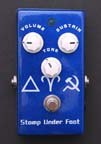
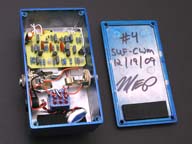
Stomp Under Foot CWM "Civil War" Big Muff clone - As this is the only clone of the CW version I have seen out there it hard to say it's the best, but I don't know how you could get much closer to the real thing. If you need a smaller and more road worthy CW Muff than your Sovtek, or if you don't have a CW yet, this is definitely the one to get. Matt's prices are probably the best out there for a Muff clone too. Right in line with the cost of a pre-assembled BYOC Large Beaver. Where the BYOC is THE budget Muff clone for the Animals/Wall/Final Cut tones, this is your Pulse era Muff clone. When I ordered this pedal Matt at Stomp Under Foot asked if I wanted his modded version or just the straight clone version. I wanted his standard unit, which had the mod. It's a tone section mod, with a resistor/capacitor combo for a better sweep of low to high - giving more range to the tone knob. This won't affect the tone in the Gilmour range, which is what I wanted to demo.
So how does it compare to the real Sovtek Civil War Big Muff? Pretty darn close! I have three slightly different CW Muffs. I picked the most Gilmourish sounding one to compare the Stomp version against in the clips below. In the noise area, the CWM is slightly quieter than the Sovteks. Mine are not particularly noisy though. The C.W.M. has that typical 1990s Sovtek dark Muff tone, with the big bottom end, and the brighter mids than a vintage USA Muff, but it also has the nice "smoothness" to the tone. This is what what makes the Civil War Muff unique and much more Gilmourish than a green or black Sovteks which have more dirt. The C.W.M. is not a dead on match to my favorite CW, but Sovteks are not dead on matches from unit to unit anyway. Most fall within about 95% of each other, as does the C.W.M. The C.W.M. is slightly less fat in the bottom end than my Sovteks, but not by much. That's close enough for me to highly recommend this.
The enclosure is a standard Boss size. DC jack and internal battery connector. Metal flake paint job. Graphics are simple - triangle, rams horns, and Russian symbol - referencing the various vintage Big Muff favorites. Matt used these same graphics on all his Muffs at the time of this review. A look under the hood revealed a nice clean board, decent top notch wiring job, and true bypass switch. Matt used 2N5089 transistors. Probably as close to the Russian transistors used in the original Civil War Muff as you can get. The cost was $130 when I purchased mine in 2008.
Here are the clips. Strat with Seymour Duncan SSL-5 bridge pickup into a clean Fender Twin Reverb.
SUF CWM sound clip - Pink Floyd's Comfortably Numb solo. Fender Strat with Boss CE-2 chorus and TC Nova delay into a Twin Reverb.
Civil War Big Muff vs. C.W.M. Clip 1 - In the Flesh and strumming chords. Big Muff first then CWM
Civil War Big Muff vs. C.W.M. Clip 2 - Picking notes in chords. Big Muff first then CWM
Civil War Big Muff vs. C.W.M. Clip 3 - Solo noodling. Big Muff first then CWM
Here are clips comparing the CWM to some other similar Muff clones. Strat with Seymour Duncan SSL-5 bridge pickup into a clean Fender Twin Reverb. Pedal settings shown below.
Comparison Demo 1 - Stomp CWM, BYOC Large Beaver Ram's Head specs, AA Green Russian
Comparison Demo 2 - Stomp CWM, BYOC Large Beaver Ram;s Head specs, AA Green Russian
Review written in 2009
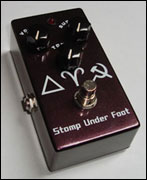
Stomp Under Foot VRH "Violet Ram's Head " Big Muff clone - This is the Stomp Under Foot replica of the "violet" spec V2 Ram's Head Big Muff Pi circuit from around 1973. Electro-Harmonix used over a dozen different versions of the Big Muff circuit in the V2 (Ram's Head) from the early to mid 1970's. Around 1973-74 this particular version appeared, and EHX made more of it than any other variant. The enclosures were often printed with purple or violet colored ink, rather than the standard red and black Big Muff colors. This led to the nickname "violet" Ram's Head Big Muff. It was a popular version for Muff DIY'ers when Big Muff schematics were spreading around the internet in the late 1990s. It makes for a Big Muff with more clarity and a bit less bottom end than a typical V2, and one that stands out in a band mix very well. The SUF version is an exact replica of this famous circuit.
I compared the VRH to two vintage V2 Ram's Head Big Muffs, two V1 Triangle Big Muffs, and two different violet spec Big Muffs, and a BYOC Large Beaver V2 clone. I set my violet V2 to my favorite tone setting - tone at 10:30 (o'clock) and sustain at 3:00, then matched the tone and sustain of the other pedals so they sounded as close to that as possible.
The VRH holds its own pretty well against the vintage Big Muffs. It is voiced a bit different than a typical V2 clone, as the violet version should be. Less bassy bottom end, but still a nice thick V2 sound, with a scooped mid range, but and lots of clarity. Compared to a BYOC Large Beaver (Ram's Head spec), I found the Beaver has more bottom end and a bit more wildness and hair. I don't know if I would call the VRH a better pedal than the Beaver - the tones are slightly different, but it definitely hits a sweet sound I can't get with the Beaver. Comparing it to my real violet Ram's Head Big Muffs, I found it sounds about 85-90% the same. The VRH is a bit fuzzier on low notes and chords, slightly less punchy, with more bottom end. Keep in mind my real violet Muff's are over 30 years old so some component values have changed as they aged. It may have sounded identical to the VRH when new.
The VRH has very usable sounds across the spectrum of the tone pot sweep, which you don't often find with a Big Muff. Even the full on treble end sounded very good. Usually the tone pot of a Muff has a short area where the sweet spot is than most players gravitate too, and the rest of the tone and treble sides are useless. Matt at SUF gives his VRH a tone section mod, with a resistor/capacitor change to increase the usable area of the tone pot sweep. The cleanup at low guitar volumes and crunch at max sustain is like a typical V2 Muff, in that it gets muffled, but still usable compared to most Muffs. It sounds great playing leads, with a nice vintage Big Muff character. No crazy screaming sustain with this one, just the normal amount for a V2, which is more than enough. Rhythm and chords sounded super clean and articulate, more clean than most my vintage Muffs. I play a lot of Pink Floyd and this is perfect for that. It was right at home with my Boss CS2 compressor, CE2 chorus, and TC Nova delay into a clean Hiwatt or Fender Twin. It sounded good playing some doomier Smashing Pumpkins stuff too, though a bit lacking in bass. It does not have the crunched fuzz of the Pumpkins' Siamese Dream op-amp Big Muffs, but more like the Pumkins' live tones. Muffs are noisy by nature and get noisier when stacked with other pedals. The VRH noise level was about the same as a typical V2 and other clones.
The SUF 73 Ram's Head reviewed above has a very similar circuit. Comparing the two, it is very similar to the SUF Violet Ram's Head, with a bit more note clarity, and a bit more bottom end.
It did not beat any of my original violet Big Muffs for tone, but it holds its ground, and rivals my BYOC. If you have never owned a vintage Big Muff, and have no intention of going that route, this is n excellent alternative. The enclosure and circuit board work look top notch. 2N5089 transistors, true bypass, 9v or standard AC jack. Great price too, compared to most other Big Muff clones. Highly recomended.
SUF VRH sound clip 2 - Tone pot sweep, playing solo leads.
SUF VRH sound clip 3 - Tone pot sweep, playing arpeggios, chords, and a bit of Cherub Rock.
Review written in 2009
TopTone DRIVEGATE DG-2
TopTone DRIVEGATE DG-2 - The DG-2 is a replica of the Pete Cornish G-2 circuit. First off, I have to say I own and love the Cornish G-2 which this pedal is based on. It had been on my board for about a year at the time I wrote this review, so I was very familiar with it's tone. I had no interest in replacing it, I just wanted to try out a TopTone pedal, so this is the one I decided to start with. It ended up replacing my G-2. Dave Kilminster is using this pedal for most of the David Gilmour guitar solos he plays in Roger Waters 2010/2011 The Wall tour at the time I write this.
TopTone is a small pedal maker out of Brazil operated by Olmar Garcia. TopTone has been around for about a year, but Olmar has been making pedals for friends since around 1998. He also plays guitar, and like many of us, David Gilmour is the reason he started playing. He is a fan of David's Pete Cornish pedals, and the first three pedals in his line are based on the Pete Cornish P-2 (DriveGate DG-1), G-2 (DriveGate DG-2), and SS2/3 (Light Drive), so they definitely caught my interest. You can say what you want about the fact that these are all clones of Pete Cornish pedals and the obvious reference to David Gilmour in the name. Ethical? Not exactly, but this is a small one man shop, so the actual number of these pedals that get out there is relatively small (mine is #497), and the Cornish wait times are not getting any shorter. The pedal names get the attention of the Gilmour players he is targeting, but honestly, I'm a bit indifferent about it all. I don't think many of the people who buy a DG-2 would have paid the price for the Cornish to begin with, though Pete is probably not too pleased. I could go into the fact that all Pete's pedals are based on other pedals as well, but I don't want to slam Pete. Pete is not an originator, but he improves what is already out there. I respect him and think he worked some magic mojo with the tone circuit of this Big Muff, which was something unique. TopTone has done something similar with the DG-2 - smaller box, less expensive, and altered the clipping section.
The DG-2 pedal graphics are kind of neat. Look closely in the Stargate wheel graphic and you will find the Sovtek star bird, the Cornish G-2 font (bit of a give away there), Big Muff Pi symbol, and the Civil War Big Muff Pi symbol. Why the Stargate television show reference in the name, font, and graphics? The idea came from Olmar's six year old son, who, along with Olmar, is a fan of the show. That is the essence of personalizing your boutique pedal!
The DG-2 (and G-2) are yet another spin on a Big Muff circuit, but this is one of the most unique takes on a Big Muff I have ever heard, in that it has none of the characteristics of a Big Muff tone. This has elements of creamy Marshall amp distortion and the grit of a ProCo Rat, with a bit of warm fuzz on top, partly due to the Germanium clipping diodes. I think this is a Rat killer, as I will probably never play my Rat again. Middy and crunchy. No deep, scooped Big Muff tones here, but it has balls. There are some very unique characteristics that I have not found in other distortion pedals. Much of the distortion you hear on David Gilmour's Live in Gdansk CD and Remember That Night DVD are this circuit through a Hiwatt. It was made to go with that amp, but I get great tones out of it with my Fender Twin and even some good tones through my Mesa Express. It sounds best with a clean amp, but it is more versatile on a dirty amp than a typical Big Muff. The tone cleans up well with the sustain dialed down, there is very good interaction between the tone knob and the sustain control, just like the Cornish G-2. All parts of the tone pot sweep seem to be usable when you dial in the right amount of sustain. There is a lot of gain on tap, but it gets noisy with more gain, just like a Big Muff. It sounds just as good with the bridge as the neck pickup. There is a nice smooth drive tone when the sustain is dialed almost off and the tone dialed up over 75%, but the preferred settings are the ones Gilmour uses. This is the pedal for the modern Gilmour tones. It sounds great playing the older Gilmour Fuzz Face, Big Muff, and Rat solos too. It really nails that live in Gdansk sound. I have found it is great for other Marshally classic rock playing as well.
So how does it compare to the real Cornish G-2? Hear it for yourself in the clips below. At certain settings this is practically the same pedal. Black Strat into Reeves Custom 50 with a bit of TC nova delay.
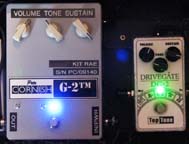
G-2 Versus DG-2 - Solos, bridge pickup
G-2 Versus DG2 - Bridge/middle position and neck pickup
G-2 Verus DG-2 - Shine On solo - neck pickup tone
G-2 Versus DG-2 - Chords, rhythms, riffs
I hear no tonal difference in the two pedals when using the David Gilmour settings from the OAI board. Both sound the same through my Reeves Custom 50 and Fender Twin. The main difference is the sustain/gain. When dialed fully clockwise there is more gain with the DG-2. I love the G-2, but that's the only area I thought it was lacking. The DG-2 may be a hair brighter at full sustain too. Both pedals react the similarly, and sound killer when boosting with a Tube Driver or Demeter Compulator, but the Dg-2 sounds better with the TD to my ears than the G-2.
The only other slight difference is when the sustain is dialed almost completely off, and the tone set almost completely clockwise like Gilmour's alternate G-2 settings (see the tick marks on the OAI board), the tones do not exactly match. I think the G-2 sounds slightly better at these settings, but hear the difference for yourself. Black Strat again into Reeves Custom 50 with a bit of TC nova delay.
G-2 Versus DG-2 - Gilmour Alternate Light Drive Setting Clip 1
G-2 Versus DG-2 - Gilmour Alternate Light Drive Setting Clip 2
Here is my favorite Gdansk Gilmour tone with the DG-2 - Echoes! Bridge and neck pickup comparisons using the BK Butler Tube Driver as a light drive boost and a 440ms delay from a TC Nova.
G-2 Versus DG2 - Gdansk Echoes tone with Tube Driver Boost and 440ms delay
DG-2 - Noodling with Strat and Reeves Custom 50
The G-2 comes in a massive, but very solid enclosure. The DG-2 comes the standard sturdy Boss sized enclosure, powered by a standard Boss AC/DC adaptor jack, or 9v battery. Comparing the noise floor of the two pedals, the DG-2 is definitely noisier than the G-2, and not just when the sustain is cranked on full. If you are used to Big Muff noise though, this is nothing that will bother you. There are other differences between the two pedals. The G-2 includes Pete's famous buffer, which is buffered in bypass mode. The DG-2 has no buffer, and is true bypass. A look under the hood of the DG-2 reveals some solid soldering work, and good quality components, from what I can see - the board is partially gooped. The pcb is securely mounted at three points, with the components facing inward when changing a battery. Very sturdy. The electrolytic caps of the G-2 are tantalum caps in the DG-2. The Germanium clipping diodes in the G-2 are a mix of Ge and Silicon in the DG-2, giving it a slightly better sound at high gain. The transistors are different too. TopTone screens them like other boutique makers - for approximately every thirty transistors only around five will be perfect for use.
As the only other option out there, at the time I write this, for the very expensive and hard to find G-2, the DG-2 is also on the expensive side ( $310 including shipping at the time I wrote this). That is about half what I paid for my G-2, and roughly double what most other boutique Big Muff pedals cost. Overall, I was impressed with the pedal though. As much as I love my Cornish G-2, the DG-2 just had a slightly better tone to me and more gain that I use. That, and the space recovered on my board by getting rid of the G-2 were enough for me to replace it with the DG-2. You can't go wrong with either pedal though!
Review written in 2010
Sustain Punch Creamy Dreamer
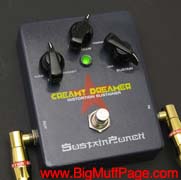
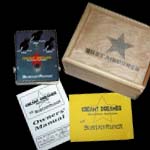
The Creamy Dreamer is a unique and original pedal created by a young, ingenious Canadian pedal maker, responsible for the all of the Smashing Pumpkins guitar tones...umm, well no, not really. It actually turned out to not to be a Smashing Pumpkins used or endorsed pedal at all, but simply an expensive boutique modded Big Muff circuit. Before you hear about how the pedal actually sounds, you may find the story behind this infamous pedal interesting, entertaining, and educational.
In the mid 1990s Billy Corgan's guitar tones from his band Smashing Pumpkins were all the rage in the guitar world. Specifically, many guitarists were after the tones heard on the 1993 album Siamese Dream, arguably the Pumkins best album (though I like all of them!). Billy had stated he used a vintage Big Muff on SD, but no one knew which version, or how it was used. In 1998 a high school student from Ontario, Canada named Jeff D (I'll leave the last name out to protect the guilty and/or innocent) was modifying Russian Big Muffs with a combination of several mods for the circuit. It seems he gleaned his Muff knowledge mostly from questioning other knowledgeable DIYers on the old AMPAGE forum and his own experiments, in an attempt to make it sound like the SP Big Muff tone. Jeff then began offering to mod the Russian BMP pedals online through a Smashing Pumpkins fan site (smashing pumpkins.org), and eventually sent one to Billy Corgan in 1999, who sent an email back to him complementary of the pedal. Jeff then began offering a new "Creamy Dreamer" pedal for sale through his sustainpunch.com website for around $200, which was very high for a boutique pedal at the time. The Sustain Punch website noted Billy's email about the pedal, and implied that the Pumpkins liked it and that an endorsement and signature series was in the works. Many people thought the website implied the pedal was something new, endorsed and currently being used by the Smashing Pumpkins on their new album, Machina. I saw the old website, and I have to say, that is exactly how I remember it, and it was implied this pedal was an original design, and all the work of Jeff, with no mention that it was essentially a Big Muff clone, or thanks to the people who explained how the circuit worked for him, and gave him advice on mods. The circuit board of Jeff's CD was coated in thick paint, presumably to hide the fact that it was simply a modded Big Muff.
The Creamy Dreamer seen in the demo sessions for Zeitgeist in 2005. From the Inside The Zeitgeist Documentary.
I do think the consumers who bought the pedal and the dealers who promoted the pedal blew the SP relationship more out of proportion than what was actually stated on the Sustain Punch and Smashing Pumpkins websites, but the hype spread, and the pedal became very popular for a few years as THE pedal for the Smashing Pumpkins tone. A story appeared in the Toronto Sun about Jeff, claiming the pedal created by the 19 year old was responsible for the Smashing Pumpkins sound and that they contacted him about doing an endorsement deal. Even Rolling Stone magazine reported the sound on the new Smashing Pumpkins album was created with Jeff's Creamy Dreamer pedal. Some were even stating that this was the pedal used on Siamese Dream, an album recorded years before the pedal was even made! A few major music gear chains picked up the pedal and thousands of units were sold. Billy Corgan has since stated he did strum a few chords on the pedal he was sent, and did send an email to Jeff complementing him as a matter of politeness, but nothing more. I have read in a few places that one of the Pumpkins crew claimed that they did use the pedal at some point on the Arising tour in '99, but that it was never used on any recording prior or since. It was used by Billy in 2005 during the demo recordings for the Zeitgiest album in Scottsdale, Arizona, although it is unknown whether it was used in the later recording sessions for the actual album.
The Creamy Dreamer seen in the demo sessions for Zeitgeist in 2005. From the Inside The Zeitgeist Documentary.
Billy's statements indicate he feels that his comment was exploited, as he never endorsed, or used this pedal on any Smashing Pumpkins recording, and that he was just being nice to a kid who sent him a pedal. When word about the real story behind the CD pedal spread quickly on the internet, the hype soon died down. There was a lot of backlash against Jeff on the DIY forums over the whole affair, to say the least. Many people expressed anger over him using their ideas to make his pedal. Ron Neeley of Ronsound even claimed Jeff stole the ideas used in the CD from mods he was already doing to BMP's at the time.
In the end, the Creamy Dreamer was simply another modded version of a Big Muff made by another boutique pedal builder, no different that what dozens of other builders have done, using mods now commonly and freely shared. There has been no shortage of boutique pedal makers since then who have sold pedals that attempted to reproduce the Smashing Pumpkins sound. Skreddy Pedals is one maker that did it, with pedals given obvious Smashing Pumpkins-like song names like the Zero, Mayonaise, and Mayo (Billy Corgan has actually used Skreddy Pedals - the Skreddy Echo was on his 2012 pedal board). Devi Ever made several Pumpkin's inspired pedals, like the Rocket (Corgan owns one), Soda Meiser, and another supposedly requested by Corgan, called the Silver Rose (Corgan hated it, resulting in another messy non-endorsement). Those makers also sold a range of other non-Pumpkins inspired pedals though. The CD was perhaps a good lesson on why not to attempt to run a business based on one product that was not terribly original. The Sustain Punch website was closed down in 2000, although the BMP mod was still offered by Jeff for a few years afterward. I'm sure he has moved on to other things now, but the myth of the Smashing Pumpkins' use of the Creamy Dreamer pedal remains. At the time I wrote this article (2008), it was still being perpetuated on various websites and ebay auctions. I even pulled this silly and very inaccurate tidbit off of Amazon.com's Pumpkins' bio.
'After Gish, the band toured, enjoying a cult following from the release of Gish, which sold close to a half million records in a couple of years. Billy began some experimentation with the band's sound, often setting up multiple effects loops for one guitar alone. The sweetheart of this era is the "Creamy Dreamer" Sustain distortion, behind some of the band's "wall of sound" that defines this era of the band.' - Smashing Pumpkins bio on Amazon.com
While working on the Smashing Pumpkins' abandoned Teargarden by Kaleidyscope project in 2009, Billy Corgan revealed in a blog that he used a vintage late 1970s Big Muff for Siamese Dream, which appears to be an op-amp Big Muff. I have written about it in this section.
THE PEDAL - So how does the Creamy Dreamer pedal sound? Quite good and unique for a Big Muff actually. There is a lot of over the top gain, smooth Big Muff type distortion, but not a lot bottom end that defines a Russian Big Muff. Not what I would call "creamy", but the smooth character of the Russian Big Muff's could be called that. The "punch" knob has a ridiculous amount of volume. I found unity gain around 3, and the rest was pretty useless. The tone knob is wired in reverse. Turning the sustain to max easily gets you a smooth high gain distortion, much more gainy than any stock Russian BMP, but with that high gain comes a lot of noise. Though it is not a very versatile pedal, it does what it does well. A stock Russian Big Muff has a bit more versatility, albeit much lower gain. The CD tone is reminiscent of some Smashing Pumpkins tones, but so are a lot of other Big Muff pedals, and it should be stated there is no ONE Smashing Pumpkins tone. Billy Corgan is a fuzz/distortion maestro and used a wide variety of pedals, amp distortion, and recording techniques for his various Pumpkins tones, many of which were based on some of his favorite tones from other bands. The CD is not the best pedal for the Siamese Dream tone by any means, but it does sound similar to some of the tones I hear on Machina, and it works fine for a generic Pumpkins tone, though severely lacking in bottom end. The pedal was well made for the time, housed in a nice Little Big Muff sized enclosure with a pseudo-cyrillic font and red Russian star graphic, presumably and omage to the Electro-Harmonix Russian Big Muff. It was even packaged in a wood crate box just like the Russian BMP crate.
People to this day are still fascinated about the myth that some super secret mods were done that make it sound magical, but there are very few people have even heard it. Various Creamy Dreamer mods for the Big Muff can readily be found by browsing the web or DIY forums, or this site. They are rather easy and inexpensive to do for anyone handy with a soldering iron. The jumpered emitter resistors mod, also called an emitter lift mod, and the enlarged limiting resistors are the two most pupular. The trace I made of my circuit is here if you want to see it. If you look at a Big Muff circuit you find 4 transistors, 22 resistors, 13 capacitors, four diodes. What do we have in the CD circuit? 4 transistors, 23 resistors, 13 capacitors, and four diodes, making it appear to be a stock Muff, but three of those resistors are for the LED and power filtering. The circuit was not based on a Russian Big Muff at all. It is more similar to a mid '70's Ram's Head. There is no limiting resistor mod, but three emitter resistors are removed in the first three stages. The tone stage is modified with matching 47k high pass and low pass resistors at R5/R8, flattening the mid scoop out somewhat. Basically, more gain, lower bass, and flat mids.
If you want a pedal that nails the high gain "creamy" sound of the CD, is more versatile, and has more of the big Sovtek bottom end the CD is missing, look no further than the Blackout Effectors Musket. It nails the CD tones, and it IS based on a Russian Big Muff, with a preamp stage patterned after an Electro-harmonix LPB-1. If you want the Siamese Dream distortion tones, get an old op-amp Big Muff or one of the clones.
Review written in 2009, update in 2012
Blackout Effectors Musket V2
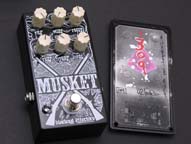
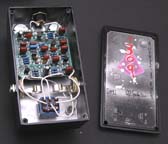
The Blackout Effectors Musket covers the Sovtek Russian Big Muff territory very well, but this is a very versatile pedal, with much more gain and tone control than a Sovtek. It also does light overdrive tones very well, which most Big Muffs do not. Essentially this is a Sovtek Bubble Font Green/Black Russian Big Muff circuit with an Electro-Harmonix LPB-1 booster circuit in the front. It has the standard volume, tone, and sustain knobs of a typical Big Muff, but there are three additional controls. One is a PRE knob (a modded LPB-1 circuit) that adds a boost of gain, sort of like what a booster/overdrive does. This is a very nice feature to have in one pedal with the Muff, and it adds some nice clarity to the monster Muff tone. In fact I wish all Big Muff clones had this feature. There is a mids knob to tailor the mid range, which is great for those of you that dislike the Big Muff mids scoop. The last control is a focus, which is sort of a saturation control for the LPB-1, to control how it blends with the input stage of the Big Muff circuit. I have not gotten that control to do much in the tone range I use, so I usually keep it at maximum saturation. Turn the fuzz knob way down, turn up the mids and pre, and this easily gets into light boost LPB-1 overdrive territory, but it is more versatile since the Big Muff tone control is also part of the same circuit. I was able to get some great creamy overdrive sounds with the fuzz dialed, the pre cranked, and the tone and mids dialed up around 75%.
Sound quality is excellent. About the same amount of noise as a BYOC Large Beaver muff clone, and slightly less than a Sovtek Muff at the same sustain setting. It nails the 1990s Sovtek Muff tones very well, even into the smoother Civil War Big Muff range. It also nails the high gain, smooth Creamy Dreamer tones. It cannot quite get close to vintage USA Big Muff tones, partly due it's heavier bottom end that is more like a Sovtek. It cleans up at low volumes nicely. It can do modern White Stripes Big Muff tones with no problem, and gets into the over the top Smashing Pumpkins range, though I was actually less impressed with the Musket for Pumpkins tones.
Keep in mind, this does have SIX knobs, so if you don't like to tweak and prefer to just set the controls to what you want and go, the huge tone range this has may be useless to you compared to other Sovetk style Big Muffs. On the other hand, if you have had a hard time finding a Muff you like, I would be very surprised if you could not dial in the tone you were looking for with this.
The enclosure is the typical Boss pedal size. Power is external only, NO BATTERY. I prefer batteries for this circuit, but there is not room in the enclosure for one. I took a quick look under the hood and found a typical four transistor (all 2N5089 tranys) Big Muff circuit, with some extra stuff for the added pot controls, and another transistor stage for the PRE (LPB-1) circuit. I paid $165 for mine used, but I think they sell for a bit higher than that. Still, not bad for what you get. Killer graphics too, and a hand painted serial number inside. Overall this is a very impressive pedal, and probably the best Sovtek style boutique Big Muff on the market. Really nice work from Blackout Effectors.
Here are the clips. Strat with Seymour Duncan SSL-5 bridge pickup into a clean Fender Twin Reverb.
Musket Sound Clip 2 - Pre set to 75%, Mids 100%, Gain 50%, then boosting mids to 100%
Musket Sound Clip 3 - Slightly dirty, low gain
TURN YOUR MUSKET INTO A CIVIL WAR BIG MUFF - The settings shown above match the tone of a "Civil War" Sovtek Big Muff with the tone at 35=40% and sustain at 100%.
Here are clips comparing the Musket to some other popular Muff clones. Strat with Seymour Duncan SSL-5 bridge pickup into a clean Fender Twin Reverb. Pedal settings shown below.
Review written in 2009
This is a review of two replicas of the vintage op-amp Big Muff, the fourth version of the popular Electro-Harmonix pedal, discontinued in the late 1970s. The ICBM, first introduced in 2005, is from Euthymia/Erik Miller, and the Op-Amp Fuzz is from Stomp Under Foot made in 2010. For anyone not familiar, op-amp Big Muffs were only made for a few years in the late 1970s. They are a bit rare but can be found on ebay every now and then for around $150-250. Version 4 Muffs are rarer so they typically sell for more than the Version 5, which was practically the same circuit with a switch that allowed bypassing the tone section. Here is some more info and history of the op-amp Big Muffs. This particular sound was made popular by guitarist Billy Corgan of the Smashing Pumpkins in the 1990s, and from all of the information available, it appears he used the V4 op-amp Big Muff.
I had never played either op-amp replica, but I read some complaints from ICBM users who said their ICBM sounds different from a vintage op-amp, so I was interested to see how they compare. MuffinMan74 from The Gear Page offered to let me test drive his ICBM, and Matt at Stomp Under Foot offered up his Op-Amp Fuzz to check out (thanks guys!). I compared both to My Version 4 op-amp Big Muff. I have owned a few V4 Muffs and found they sound very similar from unit to unit. Slight treble and bass differences, but nothing as extreme as the transistor Big Muffs. The first thing I noticed is that setting the knobs on the replicas to match the knob positions on the V4 does NOT produce the same sounds. This is a common mistake people make when comparing vintage pedals to replicas. I set the V4 to the sound I like and then tweaked the knobs of the replicas to get as close to that sound as possible. The ICBM tone/sustain pots are very different from the V4 in the same positions. That may be why some people thought it sounded different from a V4 - They did not take the time to find the matching settings. The SUF was fairly close. Here are the settings to match my V4 used in the clips below.
Both pedals sound slightly different from each other, and both slightly different from the V4. Erik at Euthymia said his was based on an op-amp Little Big Muff and verified against a V5 Big Muff and Matt at SUF said his was based on a V4 Big Muff. If you look at each of those original circuits, they are slightly different. The ICBM uses NOS op-amps also, so that may account for some of the difference between it and the SUF. Both the ICBM and SUF seem to have a slight bit more gain than the V4. The ICBM had the most gain, but I had to back the gain way down to get into the tone range that matched my V4 (the tone and sustain pots are very interactive in this circuit) so it took some time to find the sweet spot on the ICBM. Found it quickly with the SUF. For the clips I used a Fender Strat with Seymour Duncan SSL-5, which is a bit hotter sounding than Fenders standard pups, into a Reeves Custom 50 EL-34 tubed Hiwatt clone. Very loud with lots of headroom and very little amp breakup.
Most people looking to buy one of these are looking for those Smashing Pumpkins / Siamese Dream grunge tones, so that's what I play in these clips. I first compared all three Muffs with a simple power chord in dropped D tuning. Some of the best SP songs are in dropped D tuning, and the op-amp Muff was MADE for deep, octave buzzing, grungy, dropped D.
Comparison Demo Clip #1 - Dropped D chords
Comparison Demo Clip #2 - Intro to Hummer
Comparison Demo Clip #3 - Cherub Rock
Comparison Demo Clip #4 - Silverf*ck
Comparison Demo Clip #5 - Tone pot sweep
Comparison Demo Clip #6 - Some White Stripes
The replicas both sound good, but are slightly different sounding from the V4. Overall, I think both come across as very good for playing SP tunes.
•The ICBM lacks some of the clarity of the V4 or SUF, and has a bit more bottom end playing some stuff, a bit brighter playing others. Still sounds good though. It seems to match more of what I hear on the SD albums when playing only the guitar, but play to a backing track with bass, and the clarity is not as evident. The SUF has a bit more clarity and crunch, which is better when playing with a backing track, or with a band against a bass guitar occupying the same scooped tone range. Maybe a bit less bottom end than the ICBM. Overall, I think the SUF sounds closest to the V4, but I actually liked it a bit more than my V4.
•ICBM had more gain than the SUF, but also tended to fuzz out more when playing chords at Max gain. Good for solos though.
•Both run off a standard boss adaptor, or 9v battery.
•The ICBM enclosure is the larger of the two and takes up more space than the SUF, and looking under the hood, more than half the ICBM enclosure is empty. Maybe Erik at Euthymia just likes big look the pedal has in that large box. I prefer the real estate a smaller pedal takes up on a board though. The solder jobs look top notch on both.
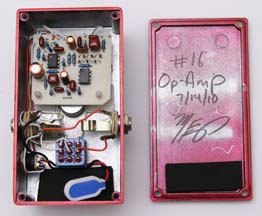
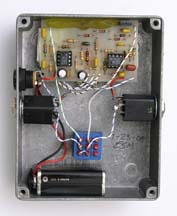
•Both are true bypass.
•Noise level at high gain is about the same for each, but it is very low for a Muff.
•The SUF includes a power LED, ICBM does not.
•The ICBM costs about $20 more than the SUF (at the time of this review), but both are reasonably priced for a hand made pedal.
Review written in 2010
